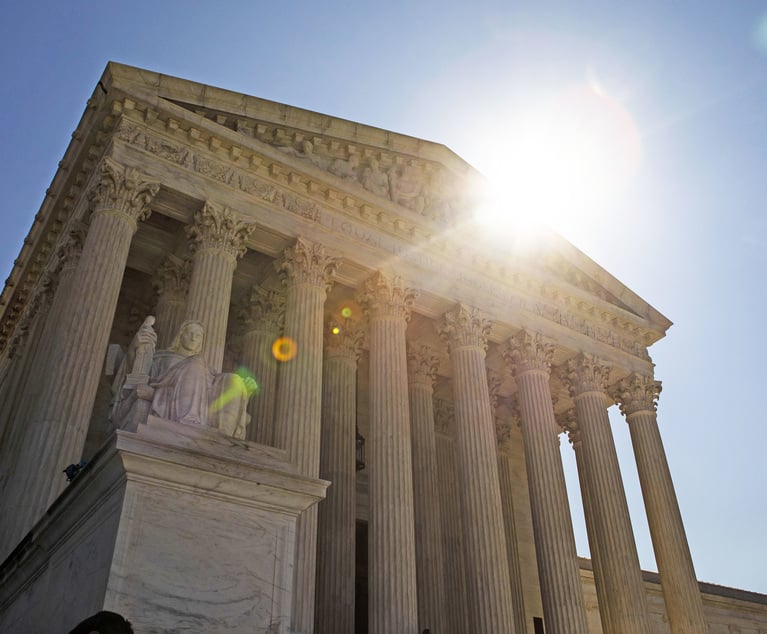 The U.S. Supreme Court. Photo: Diego M. Radzinschi/ALM
The U.S. Supreme Court. Photo: Diego M. Radzinschi/ALM Employers Await Supreme Court's Ruling on the Future of 'Chevron' Deference
"In two pending cases ... the Supreme Court will consider whether to significantly modify the doctrine, or even abandon it completely," write Michael Slocum and Pamela White of Greenberg Traurig.
May 06, 2024 at 12:00 PM
7 minute read
When Congress passes legislation, it frequently directs that one or more federal agencies promulgate regulations both implementing the law and filling in details Congress may have left unaddressed. When agencies promulgate these regulations, it often falls to federal courts to review whether those regulations are based upon an appropriate interpretation of the statutes Congress enacted. Inevitably, the executive and judicial branches of government will sometimes have differing interpretations of the language in these statutes. The U.S. Supreme Court considered this interplay of powers in its decision in Chevron U.S.A. v. Natural Resources Defense Council, 467 U.S. 837 (1984). There, the court announced a two-step framework that courts have since utilized to review an agency's statutory interpretation, an approach commonly called "Chevron deference." This analysis requires courts to first ask whether Congress directly and unambiguously addressed the question at issue. If Congress' intent is unclear because the statute is silent or ambiguous, then "the question for the court is whether the agency's answer is based on a permissible construction of the statute." If so, the court is to defer to the agency's interpretation, even if the court would have independently come to a different conclusion.
Chevron deference has frequently been challenged and critiqued since the court established the doctrine in 1984. In two pending cases, Loper Bright Enterprises v. Raimondo (No. 21-5166); and Relentless v. Dep't of Commerce (No. 22-1219), the Supreme Court will consider whether to significantly modify the doctrine, or even abandon it completely. In both cases, the court will squarely consider "[w]hether the court should overrule Chevron or at least clarify that statutory silence concerning controversial powers expressly but narrowly granted elsewhere in the statute does not constitute an ambiguity requiring deference to the agency." Decisions are expected later this term.
This content has been archived. It is available through our partners, LexisNexis® and Bloomberg Law.
To view this content, please continue to their sites.
Not a Lexis Subscriber?
Subscribe Now
Not a Bloomberg Law Subscriber?
Subscribe Now
NOT FOR REPRINT
© 2025 ALM Global, LLC, All Rights Reserved. Request academic re-use from www.copyright.com. All other uses, submit a request to [email protected]. For more information visit Asset & Logo Licensing.
You Might Like
View All
Was $1.3M in 'Incentive' Payments Commission? NJ Justices Weigh Arguments
3 minute read

After DEI Rollbacks, Employment Lawyers See Potential For Targeting Corporate Commitment to Equality
7 minute read
Law Firms Mentioned
Trending Stories
- 1States Accuse Trump of Thwarting Court's Funding Restoration Order
- 2Microsoft Becomes Latest Tech Company to Face Claims of Stealing Marketing Commissions From Influencers
- 3Coral Gables Attorney Busted for Stalking Lawyer
- 4Trump's DOJ Delays Releasing Jan. 6 FBI Agents List Under Consent Order
- 5Securities Report Says That 2024 Settlements Passed a Total of $5.2B
Who Got The Work
J. Brugh Lower of Gibbons has entered an appearance for industrial equipment supplier Devco Corporation in a pending trademark infringement lawsuit. The suit, accusing the defendant of selling knock-off Graco products, was filed Dec. 18 in New Jersey District Court by Rivkin Radler on behalf of Graco Inc. and Graco Minnesota. The case, assigned to U.S. District Judge Zahid N. Quraishi, is 3:24-cv-11294, Graco Inc. et al v. Devco Corporation.
Who Got The Work
Rebecca Maller-Stein and Kent A. Yalowitz of Arnold & Porter Kaye Scholer have entered their appearances for Hanaco Venture Capital and its executives, Lior Prosor and David Frankel, in a pending securities lawsuit. The action, filed on Dec. 24 in New York Southern District Court by Zell, Aron & Co. on behalf of Goldeneye Advisors, accuses the defendants of negligently and fraudulently managing the plaintiff's $1 million investment. The case, assigned to U.S. District Judge Vernon S. Broderick, is 1:24-cv-09918, Goldeneye Advisors, LLC v. Hanaco Venture Capital, Ltd. et al.
Who Got The Work
Attorneys from A&O Shearman has stepped in as defense counsel for Toronto-Dominion Bank and other defendants in a pending securities class action. The suit, filed Dec. 11 in New York Southern District Court by Bleichmar Fonti & Auld, accuses the defendants of concealing the bank's 'pervasive' deficiencies in regards to its compliance with the Bank Secrecy Act and the quality of its anti-money laundering controls. The case, assigned to U.S. District Judge Arun Subramanian, is 1:24-cv-09445, Gonzalez v. The Toronto-Dominion Bank et al.
Who Got The Work
Crown Castle International, a Pennsylvania company providing shared communications infrastructure, has turned to Luke D. Wolf of Gordon Rees Scully Mansukhani to fend off a pending breach-of-contract lawsuit. The court action, filed Nov. 25 in Michigan Eastern District Court by Hooper Hathaway PC on behalf of The Town Residences LLC, accuses Crown Castle of failing to transfer approximately $30,000 in utility payments from T-Mobile in breach of a roof-top lease and assignment agreement. The case, assigned to U.S. District Judge Susan K. Declercq, is 2:24-cv-13131, The Town Residences LLC v. T-Mobile US, Inc. et al.
Who Got The Work
Wilfred P. Coronato and Daniel M. Schwartz of McCarter & English have stepped in as defense counsel to Electrolux Home Products Inc. in a pending product liability lawsuit. The court action, filed Nov. 26 in New York Eastern District Court by Poulos Lopiccolo PC and Nagel Rice LLP on behalf of David Stern, alleges that the defendant's refrigerators’ drawers and shelving repeatedly break and fall apart within months after purchase. The case, assigned to U.S. District Judge Joan M. Azrack, is 2:24-cv-08204, Stern v. Electrolux Home Products, Inc.
Featured Firms
Law Offices of Gary Martin Hays & Associates, P.C.
(470) 294-1674
Law Offices of Mark E. Salomone
(857) 444-6468
Smith & Hassler
(713) 739-1250






